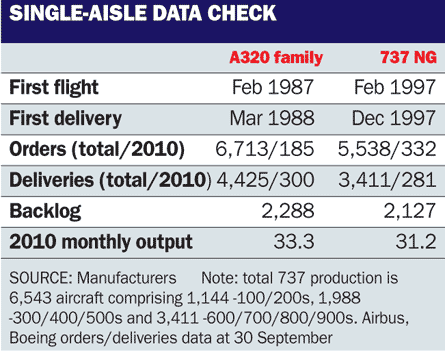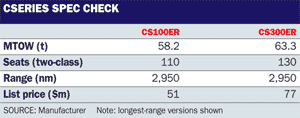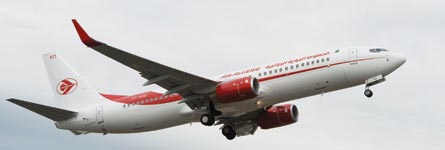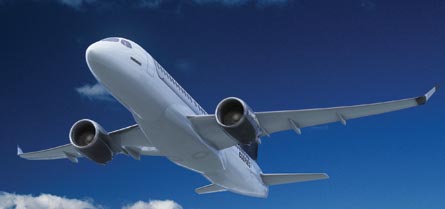Additional reporting by Jon Ostrower
Boeing appears to have opted against re-engining its narrowbody type. Instead, it is looking to a "737 Next Generation Plus" to bridge the gap between today's 737NG and a replacement aircraft in the 2020s.
Airbus, however, remains committed to offering a new powerplant for its competing A320 single-aisle family.
|
|---|
Boeing Commercial Airplanes chief Jim Albaugh has disputed this, arguing that the NEO would offer only a 3-4% improvement over today's A320 and bring the European narrowbody in line with today's 737.
Under Airbus's plans, a $7-8 million price premium would apply to the NEO. This is calculated as half the net present value of fuel savings, compared with the A320 of today.
ROLLS-ROYCE STANCE
For its part, engine manufacturer Rolls-Royce has urged the airframers to focus on bringing all-new narrowbody aircraft to market rather than re-engining existing airliners.
 Its stance has been prompted by concern that "technology refreshes" would delay the introduction of new "highly integrated and optimised" jets that could bring step-change cuts in fuel consumption and emissions.
Its stance has been prompted by concern that "technology refreshes" would delay the introduction of new "highly integrated and optimised" jets that could bring step-change cuts in fuel consumption and emissions.
All-new two- and three-shaft civil engine families are in development at R-R. Advance2 covers the market for medium-sized business jets and narrowbodies with up to 150 seats, while Advance 3 is aimed at delivering new-generation three-shaft engines for widebody airliner developments anticipated for the latter part of this decade.
Based on the E3E technology core developed by German subsidiary R-R Deutschland and in testing since 2008, Advance2 is intended to deliver engines offering a "15-20%" fuel-burn reduction, by 2016-17.
Despite lobbying for an all-new type, R-R and its International Aero Engines partner Pratt & Whitney have stood by their insistence that a powerplant offering for the A320 NEO could come via the consortium.
But the partners have been embroiled in a legal dispute over swept fan blade design, with R-R accusing P&W of infringing its intellectual property in designing the PurePower PW1000G and - with General Electric - the Engine Alliance GP7200. The Canadian manufacturer hit back by filing a complaint that "Rolls-Royce has engaged in unfair behaviour to mislead the United States Patent & Trademark Office".
For Airbus and Boeing, year-end is set to be the deadline for decisions on future narrowbody strategy. The US airframer is mulling over three options for the 737: re-engining, continuation of incremental improvements or launch of an all-new replacement. Marketing vice-president Randy Tinseth has noted that while some airlines seek a 15% improvement in fuel burn, leasing companies want nothing to change.
Boeing chief executive Jim McNerney has made no secret of his preference for a clean-sheet design. "I'd rather not put the backlog at risk twice unless we have to," he said earlier this year. With more than 2,100 unfilled 737 orders in its backlog at the end of September, Boeing intends to boost the production rate from 31.5 a month to 35 by early 2012, and again to 38 in the second quarter of 2013.

Demand for 737s has rebounded after the decline of 2009, in which annual net orders dropped to 178 from 484 in 2008. In the nine months to 30 September, Boeing accumulated 332 net orders of its narrowbody aircraft, compared with 128 orders in the same period of 2009.
If customers prove happy to wait until 2025 for an all-new narrowbody, the case for re-engining the 737 might strengthen. Either way, the more-electric architecture developed for the 787 is likely to find its way into Boeing's next clean-sheet design. With scaled-down 787 systems and a future engine offering, Boeing would aim to offer 15-20% direct operating cost savings over today's narrowbodies.
The 2013 service entry for market newcomer Bombardier's 110- to 149-seat CSeries (below) is likely to be factor in Boeing's decisions on the 737. If its choice were to re-engine the narrowbody with powerplants from CFM International and/or P&W, a 2016 entry into service would likely be the target.
In the meantime, an 737NG upgrade package is set to enter service in early 2012. Encompassing aerodynamic improvements and the upgraded CFM56-7NE engine, it is intended to deliver 2% reduction in fuel burn.
Airbus, for its part, has said it does not envisage any all-new single-aisle being viable before 2025, since one launched by the end of this decade could be obsolete inside a decade as breakthrough technologies such as open rotors mature. At $10 billion, the cost of developing an all-new type would be four times that of an upgrade programme, by Airbus's estimates.
Likely to be heavier - with higher thrust and bigger inlets - new engines may require the A320's outer wing to be reinforced. The A320 NEO is also set to be equipped with "sharklet" winglets.
Airbus Freighter Conversion has meanwhile pushed back the target certification date for its A320 passenger-to-freighter conversion programme from late 2011 to November 2012. Although widebody freighter conversions are carried out by EADS subsidiary EFW in Germany under a supplemental type certificate, the A320P2F project marks Airbus's entry to the market. The airframer holds 18% of the AFC consortium, while EFW holds 32%. Russian manufacturers Irkut and United Aircraft have 25% each.
|
|---|
With more than 2,200 A320-family aircraft in its order backlog, Airbus is to increase its monthly production rate from 34 to 36 in December. The rate will rise to 38 in August and to 40 in the first quarter of 2012. In 2009, it set a new annual A320-family deliveries record of 402. At the end of September, it had delivered 300 A320-family aircraft this year.
In the first nine months of 2010 the European airframer notched up 185 net orders of A320-family aircraft, after 36 cancellations. In the same period of 2009, net A320-family orders totalled 94.
The first 737NG disassemblies have taken place this year, despite the type entering service as recently as 1997. First, an 11-year-old 737-600 belonging to the administrators of defunct carrier FlyGlobespan was sold for parting out. This was followed by the scrapping of a two-year-old Ryanair 737-800 that had suffered undercarriage damage from a multiple bird-strike when landing at Rome Ciampino airport in November 2008.
Both twinjets were inducted by aircraft recycling and dismantling specialist Air Salvage International at its facility at Kemble airfield in the UK. While the 737-800 was retired for apparently insurance-related reasons, economics drove the decision to part out the 737-600. At 15 October, there were just 68 -600s in service, as listed by Flightglobal's ACAS database.
Last year brought the first parting out of an Airbus A318 - an ex-Frontier example - and others have followed, including some delivered as recently as 2007. As the newest A320-family variant, the A318 entered service in 2003. The total fleet is similar in size to that of the 737-600, with 71 A318s active at 15 October, says Flightglobal's ACAS database.
Appraiser and consultancy IBA has forecast that between 10 and 14 A320s a year will be part-out candidates over the next five years. These could include older aircraft operated by Air France, British Airways and Iberia.
BOMBARDIER PREDICTS CSERIES 'ERA'
By Mary Kirby
|
|---|
When no firm orders materialised, Bombardier put on a brave face and declared it anticipated "great interest in the CSeries over the long haul".
Recent comments from airlines show that Bombardier may have reason to be so confident. American Airlines' chief executive Gerard Arpey has deemed the CSeries to be "definitely worth considering" as the carrier looks to scale capacity to match growth forecasted for the rest of this decade.
Middle Eastern carrier Gulf Air has admitted it is focusing on three candidates for a permanent regional jet operation, and will choose between the CSeries, the Embraer E-Jets family and the Airbus A318.
Even Qatar Airways - long considered a likely candidate for the CSeries - appears to be back on track in negotiations with Bombardier after expressing concerns at the air show about engine maintenance costs associated with the Pratt & Whitney PurePower PW1500G geared turbofan engines that will power the CSeries twinjet.

To date, Bombardier has secured 90 firm orders and 90 options for the CSeries. But the airframer expects airlines to purchase nearly 7,000 aircraft in the 100- to 149-seat segment of the market - squarely in CSeries territory - during the next 20 years.
"I am very confident that we will fill very quickly the pipeline that we have on the CSeries in terms of all of the interactions we're having with customers all over the world. Doors are being opened. Welcome mats are being laid out. Potential customers are all extremely intrigued. They are doing detailed studies and not just giving it a cursory once-over look. They are calling us back. They are diving deep," says Bombardier vice-president commercial aircraft programmes Ben Boehm.

"As the economy continues to rebound and as airlines continue to feel the pressure of emissions trading schemes in Europe and as they go more into growth mode and stabilise their balance books, I'm very confident this will be the era of the CSeries for the next 10 to 20 years."
He stresses that the CSeries will not compete with potential successors to Airbus and Boeing's narrowbodies. "What Boeing and Airbus are talking about really is not affecting us. They are talking about 150-seats plus and that is not the CSeries market segment."
Boehm reports that "everything" is on schedule. "We're happy to constantly tell the world that the plane continues to be more and more real. The [CSeries] engine is now on the test stand in Florida. The first version of fly-by-wire control laws are already being tested by our suppliers, so [we're seeing] all the standard progress for a programme in the detailed design phase."
In another recent achievement, Bombardier mated a portion of the CSeries composite wing to the airliner's composite wingbox and conducted successful tests to mitigate any perceived risk associated with such a join.
"There have been problems in the industry, with a lot of people [wondering] about these joins. We wanted to say: 'This is not an issue. Bombardier has mastered this'," says Boehm.
Flight testing of the first CSeries, the smaller CS100, is due in 2012, with service entry in 2013. Bombardier envisages a two-day production rate, but Boehm says this can be increased.
Source: Flight International



















